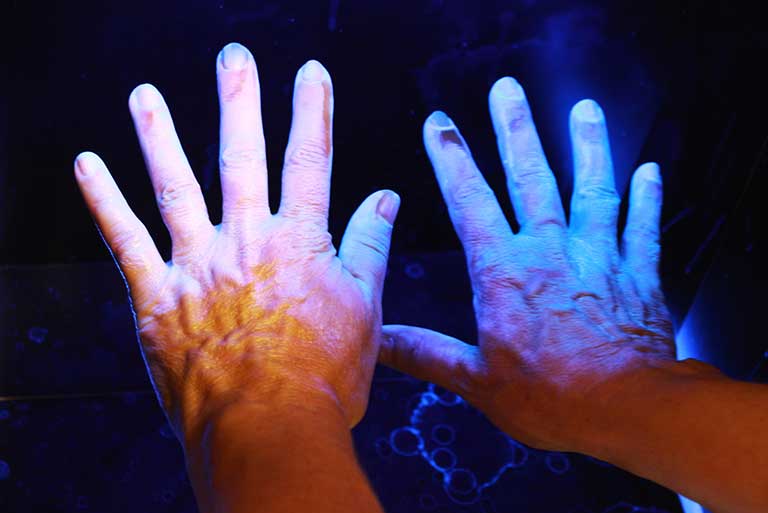All about Psoriasis
Psoriasis is a chronic skin disease that causes red, scaly plaques anywhere on the body. It can decrease the quality of life, but there are effective treatments to control it.

How is psoriasis treated?
Psoriasis needs a holistic approach, where a healthy body and healthy mind are crucial. As a result, some people may control their psoriasis simply by changing their lifestyle. However, the majority will require a pharmacological treatment.
Treatments to manage psoriasis are categorized into 4 classes: topical therapy, light therapy, conventional and biological systemic therapies. The latter two are systemic treatments but vary in forms. We call them systemic since the drug spreads throughout the body. Know that your dermatologist will often opt for systemic treatments when topical or light treatments are unsuccessful (meaning not effective enough or too many side effects).
Topical therapies
Topical therapies are applied to the skin in the form of creams, ointments, lotions, or gels. The main active ingredients are corticosteroids or Vitamin D-derivates, or a combination of both. Another topical treatment may contain calcineurin inhibitors, usually used for skin folds and facial psoriasis. When used alone, these therapies can effectively treat mild psoriasis. In moderate to severe cases, they are likely to be combined with systemic medications or light therapy.
Topical therapies of psoriasis include:

- Moisturizers and emollients. These agents help relieve itching and reduce flaking and dryness.
- Corticosteroids. These agents reduce inflammation, keratinocyte proliferation and immune system activity. Many different formulations exist solutions, foams, sprays, shampoos and gels are prescribed for the scalp, whereas ointment or creams are typically used for the face, torso and extremities.
Once psoriasis improves, applications are spaced out, to prevent adverse effects from excessive use, such as thinning of the skin. - Vitamin D analogues. These agents arrest keratinocyte growth. They could be use as monotherapy or in combination with corticosteroids.
- Salicylic acid. It promotes sloughing of dead skin cells and reduces flaking.
- Topical retinoids. They are vitamin A derivatives that help reduce inflammation.
- Calcineurin inhibitors. They are a therapeutic option for psoriasis in sensitive areas, such as the face and skin folds.
- Anthralin and coal tar. These agents reduce inflammation and skin cell growth; however, their use is becoming increasingly less popular.
When prescribed with topical treatments, ask your dermatologist how many times you need to apply them and make sure to include this in your daily routine.

Light therapy
Light therapy is also known as phototherapy. Is uses ultraviolet (UV) light, which is a very specific part of natural sunlight that we cannot see with the naked eye. There are different types of light therapy, being the most used in psoriasis ultraviolet B (UVB) and ultraviolet A in combination with psoralen (this combination is known as PUVA).
Ultraviolet light B (UVB), which is present in nature sunlight, is an effective treatment for psoriasis. It penetrates the skin and slows the growth of affectated skin cells. This treatment involves exposing the skin to an artificial UVB light source for a set length of time on a regular schedule.
Psoralen + Ultraviolet light A (PUVA), is effective specially in some areas of forms of psoriasis as the guttate psoriasis or plaque psoriasis localized in palm and soles. This treatment slows down excessive skin cell growth of the skin.
Systemic medications
Systemic medications are administered orally or injected and, therefore, their action is not limited to the skin, but act throughout the body. They are used in people with moderate to severe psoriasis or in psoriasis resistant to other types of treatments. They can be divided into two main groups: conventional (including small molecules) systemic medications and biologics.
Conventional systemic medications
Conventional systemic medications for psoriasis include:
- methotrexate
- acitretin
- cyclosporine
- fumarates
- apremilast
- systemic retinoids
These medications are taken orally as tablets or injected. They act by decreasing or altering the functioning of the immune system.
Biologics
These drugs are manufactured from living organisms and given by injection (subcutaneously or intravenously). They act on the immune system, blocking molecules involved in the inflammatory process. Depending on the molecules they block, these drugs are classified into several groups:
- Tumor necrosis factor (TNF α)-alpha inhibitors
- Interleukin 12 and 23 inhibitors
- Interleukin 17 inhibitors
- Interleukin 23 inhibitors
References
- European Academy of Dermatology and Venereology (EADV). A variety of treatments [Internet]. 2019. Available at: https://eadv.org/cms-admin/showfile/9635-EADV%20PSORIASIS-9-A%20variety%20of%20treatments.pdf
- Elmets, C.A., Lim, H.W., Stoff, B., Connor, C., et al. Joint American Academy of Dermatology National Psoriasis Foundation guidelines of care for the management and treatment of psoriasis with phototherapy. J Am Acad Dermatol [Internet]. 2019;81(3):775-804. Available at: https://www.ncbi.nlm.nih.gov/pubmed/31351884. doi: 10.1016/j.jaad.2019.04.042.
- Menter, A., Strober, B.E., Kaplan, D.H., et al. Joint AAD-NPF guidelines of care for the management and treatment of psoriasis with biologics. J Am Acad Dermatol [Internet]. 2019;80(4):1029-1072. Available at: https://www.ncbi.nlm.nih.gov/pubmed/30772098. doi: 10.1016/j.jaad.2018.11.057.
- National Psoriasis Foundation (NPF). Phototherapy [Internet]. 2019. Available at: https://www.psoriasis.org/about-psoriasis/treatments/phototherapy
Frequently asked questions about psoriasis treatment
Medications for psoriasis can be used alone or also in combination. For instance, a topical medication may be used in combination with a systemic treatment.
Your doctor will advise you when to stop taking medication.
You should never stop treatment on your own initiative, since your psoriasis could get worse. Talk to your doctor before you make any decisions.
